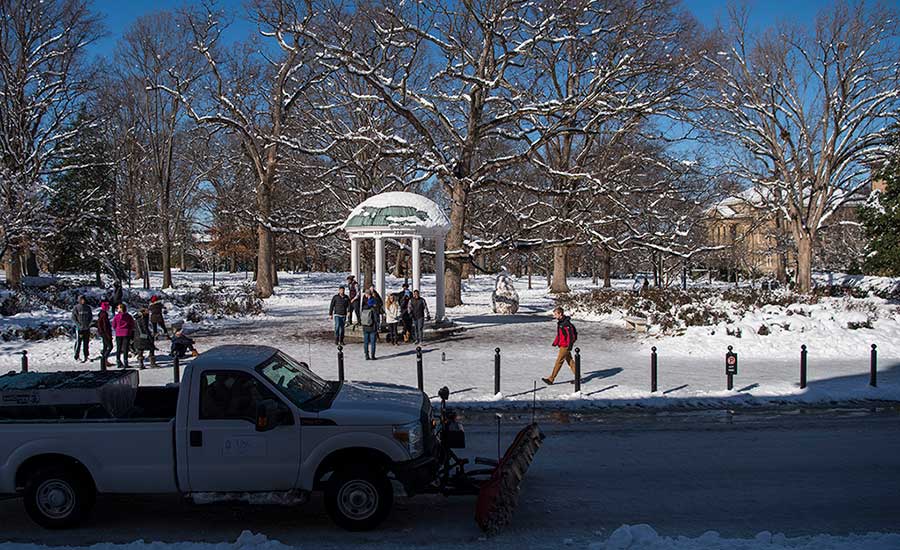
Snow started falling early on the morning of Sunday, Dec. 9, 2018, blanketing much of North Carolina by the time the sun rose. In just one day, before the winter season had officially started, UNC-Chapel Hill was covered in at least eight inches of snow, more than the total snowfall the campus sees in any average year. What was a fun distraction from exams for students meant a lot of work for many UNC Finance and Operations employees.
In anticipation of that storm, just as for any storm, a multitude of staff throughout Finance and Operations got to work to prepare campus, to make important decisions about how to keep the campus community safe and to make sure people can get to and around campus when the University resumes full operations.
Whether it involves advance planning or rapid response, there are many Finance and Operations teams that are key to keeping the campus running and making sure it’s safe during inclement weather.
Facilities Services Adverse Weather Planning and Response: “It’s a Team Effort”
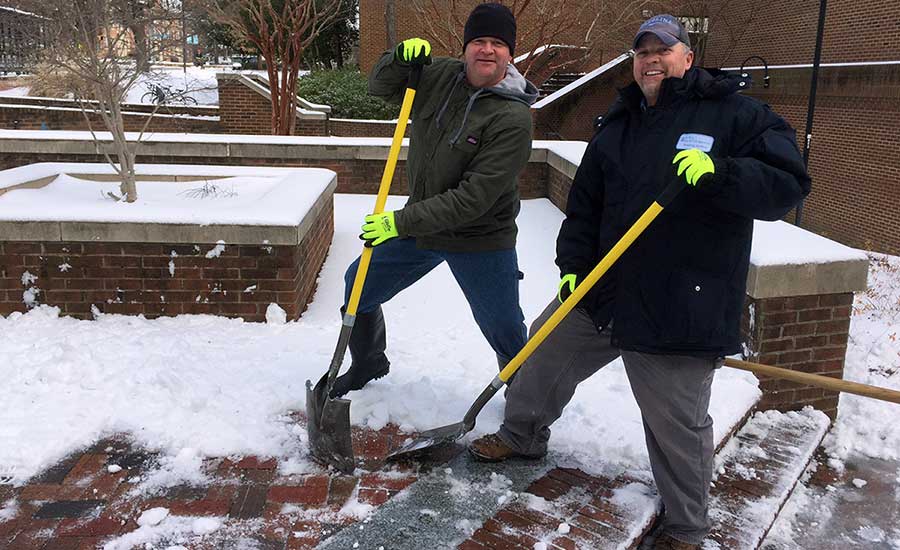
Before the weather turns crisp, Facilities Services begin to prepare for winter weather. Every September the Grounds Services Snow Team, led this year by Grounds Supervisor Kevin Denardo and Stormwater Supervisor Robert Bradley, begins to establish the Snow Plan for the upcoming season.
A key goal of the Snow Team is to ensure that all equipment needed for an adverse weather response is ready and prepared. The team hooks up and tests plows, brine tanks, tractors, skid steers and other vehicles and equipment to make sure they are in good condition and fully operational. They also check the inventory of shovels, bulk salt and sand, and other supplies to ensure that levels will be sufficient.
Denardo stresses that staff safety is extremely important. Vehicle and equipment operators are provided with maintenance and safety checklists for their equipment, which should be inspected before and after each use. The Snow Team also holds a “Snow Roadeo,” an annual training and demonstration session for staff to review snow procedures, practice hooking up and operating equipment, and to review cold weather work safety tips.
Tom Bythell, campus forest manager, explains the logistics behind clearing a campus of Carolina’s size. For the campus to open, key roads and parking lots, primary and ADA building entrances, and the walkways that connect them all must be cleared and accessible. As part of the snow planning process, staff are pre-assigned to specific zones, equipment and clearing responsibilities, so in the event of snow or ice staff can be dispatched quickly and efficiently. The campus community can see which areas and entrances are marked for priority clearing on the University’s Snow Removal Priority Map.
Twenty-four to 48 hours before snow or ice is forecast to arrive, the Snow Plan is put into action. Grounds staff spread sand and brine and Housekeeping pretreats building entrances. All vehicles are fully fueled at the Facilities Service Station and vehicles that may be hard to start in colder temperatures are moved indoors into garage bays. If extremely low temperatures are expected, Energy Management Control Systems staff monitor building and environmental systems to ensure they stay online.
Once precipitation tapers off, Facilities staff report to campus to begin clearing efforts per their assigned zones and priority areas. Grounds Services works to plow streets, parking lots and campus walkways, Building, Construction and Housekeeping Services staff begin clearing and retreating building entrances and ramps, and other departments assist where needed.

Second-shift staff are called in to assist so that clearing efforts can continue into the night as well. Some staff stay overnight to keep high priority areas such as UNC Hospitals and the Emergency Room clear and accessible. If students are on campus, maintaining access from residence halls to campus dining halls and Campus Health Services is also a priority.
Depending on University operating needs and weather conditions, 150 to 300 Facilities staff from a number of departments may report to clear campus while many more support behind the scenes. Grounds Services Director Steve Gooch is thankful for the support and assistance. “Grounds may take the lead, but we rely on our partners — it’s a team effort.”
Transportation and Parking is a key partner in campus weather preparation and response. Parking Maintenance staff pretreat parking lots, parking decks and adjacent pedestrian bridges and walkways in advance of winter weather and manage the clearing of the top levels of parking decks along with pedestrian bridges once precipitation falls.
Adrian Naylor, facilities maintenance manager for Transportation and Parking, says they take adverse weather events seriously. “We do all we can to maintain adequate and clear parking, particularly because we know UNC Hospitals require parking and safe navigation for their employees as well as visitors.”
Snow and ice can cause power outages and other impacts to Energy Services utilities operations. Cogenerations Systems are a 24/7 operation, so staff must continue to report to campus to operate the plants regardless of weather conditions. “It is always difficult to keep staff safe and equipment running during extreme weather,” says Cogeneration Systems Manager Bill Lowery, “but the University and UNC Hospitals never shut down, so we don’t either.“ Chilled Water staff take steps to provide additional backup cooling capacity should there be a power outage and monitor systems for leaks from frozen pipes. Electrical Distribution and Stormwater staff monitor systems but also provide assistance to Facilities crews with clearing campus.
Read more about how Facilities Services supports campus during adverse weather.
Emergency Operations Center: The Hub of Adverse Weather Activity
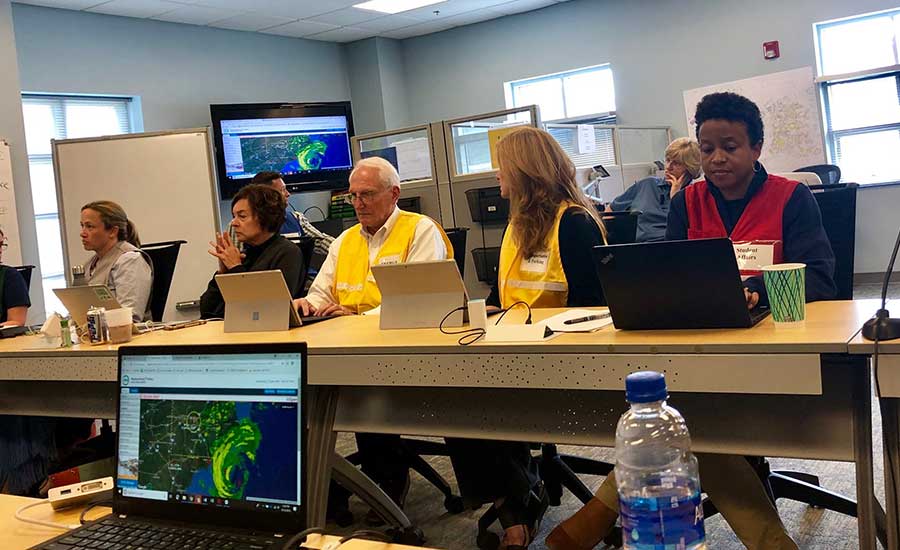
As crews work across campus, reports on campus conditions and clearing efforts are fed to the Emergency Operations Center (EOC) to support decision making and campus communications. According to Darrell Jeter, director of emergency management and planning, he and his team set up the EOC when campus needs a central coordination facility responsible for managing emergency planning and operations during any large-scale event on campus. Jeter initiates the EOC for events like basketball championship games or a major speaking event on campus. Jeter says he initiated the EOC for multiple inclement weather events in 2018, including Hurricane Florence and the December 2018 snowstorm.
“Having a central coordination center is crucial to managing resources and centralizing decision-making,” Jeter said. “We help connect 15 departments across campus with each other and with senior administrators, plus outside agencies at the town and county level. This even includes support for the Institute of Marine Sciences on the coast.”
In the case of the December 2018 snow event that prevented some staff from reporting to work easily, he set up a virtual EOC where people could check in remotely from home.
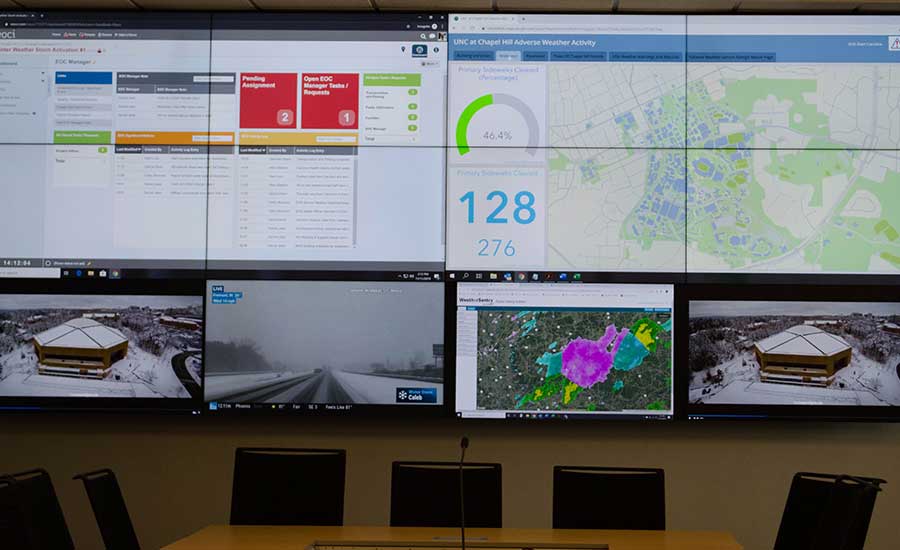
This fall Jeter and his staff adopted new emergency management software called Veoci that will better coordinate team efforts, no matter where staff are, into a virtual EOC, where everything is organized into a dashboard display and instantly archived for reporting and debriefing. Jeter started testing it with the first home football game and is still refining workflow. He says the key benefit of the new system is that it makes it easier for staff to use the software from anywhere, so when an incident happens people can use their phones, laptops, or desktop computers to be connected, gather data, generate reports and resource requests on the fly.
This year the Facilities Technology Group will also be testing a new Adverse Weather Dashboard. As Facilities crews report in, clearing locations will be updated and displayed on a campus map in real time, giving management and the EOC an up-to-date and complete overview of campus conditions at any given time.
Payroll Staff: “We Have to Be Ready to Run Payroll Regardless of Where We Are”

Not pictured: Cynthia Gunn-Johnson and Glen Lawrence.
Ask Payroll Services staff about working during weather events and you begin to realize their commitment to running payroll on time – every time. It sounds like a math equation: In 2018, the team issued payroll for 24,000 employees during two ice- and snowstorms, one water outage and one hurricane. Planning for severe weather events is nothing new and has become more frequent in recent years. With more than 250 steps involved in running payroll for employees, Payroll staff must prepare for all weather scenarios.
“The advantage is that we can confirm payroll from another location. Payroll staff don’t have to physically come to campus, but we have to be ready to run payroll regardless of where we are,” said Walter Miller, director of Payroll Services. That means staff working on Christmas Eve some years, so that payroll stays on schedule. “Almost everything can be done from home — allowing for power.”
Payroll staff plan for widespread inclement weather, but hope the plan isn’t needed. Last year, a weather forecast predicted a major hurricane and power outage for campus.
“We developed a disaster recovery plan with ITS so we could run payroll from a certain room in ITS Manning that would have enough power for the job,” Miller said.
Safety of staff is always a top priority, so Payroll was prepared to complete the payroll process with the minimum amount of staff possible to avoid unnecessary travel during the weather event. Luckily, the storm wasn’t as severe as predicted, and the business continuity plan wasn’t put into action.
“Our main purpose is to pay people,” Miller added. “Planning makes that possible.”
Environment, Health and Safety: Supporting the Research Mission
When inclement weather is in the forecast, Environment, Health and Safety (EHS) sends out a notice to all lab Principal Investigators (PIs) and Safety Supervisors, asking researchers to review the EHS Lab Emergency Preparedness Checklist and prepare their lab.
As the weather hits, EHS will send a second notice reminding them to be ready and also advising them that if the University is closed that they need to close their labs. Interim EHS Director Cathy Brennan says that there are special circumstances when some researchers are mandatory (to feed animals or to maintain a lab process), and EHS has procedures in place to support them.
“We track those researchers, so we know who is in what building,” Brennan said. “Further, if we have building issues resulting from a weather event, such as power outages, water intrusion, etc., then we send teams out to do damage assessment in labs and make sure no hazardous materials or environments have been impacted.”
Carolina Dining Services: “A Warm Meal and a Comfortable Place to Rest”
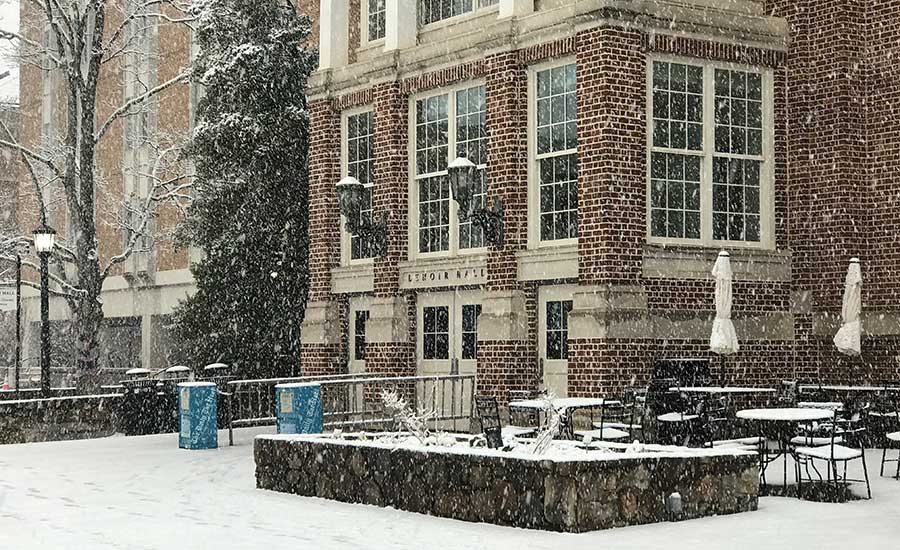
In advance of an adverse weather event, Carolina Dining Services (CDS) staff plan which facilities will be open and what the hours will be. They design menus to accommodate the forecasted conditions and the expected number of people to feed, and they identify how many staff members they will need to work. While CDS has standard emergency menus, they try to customize them to suit the specific nature of the situation. They order extra supplies in advance of severe conditions and work closely with the EOC and other departments to communicate the dining options to the campus. To ensure the safety of CDS staff, they typically reserve rooms in local hotels that are convenient to campus and assign staff with all-weather vehicles to pick up and take staff home if necessary.
When the weather hits, CDS provides warm meals to those staff members who are working on campus during weather-related events.
“Based on the approval of each department, we will set up a sign-in list at dining locations to accommodate meals at discounted rates for campus staff who are working through the weather,” said Auxiliary Services Director Scott Myers. “Many of these employees are working outside during these events under less than desirable conditions so the ability to get a warm meal and a comfortable place to rest are much appreciated.”
In September 2018, CDS partnered with the William and Ida Friday Center for Continuing Education and the American Red Cross to provide meals at an emergency shelter for hundreds of evacuees from eastern North Carolina who were impacted by Hurricane Florence. By the end of the first evening there were 166 people, and within the first week the shelter’s occupancy grew to 486 people. Carolina Dining Services Chef Christian Chiron created a menu that fed all evacuees and Red Cross volunteers (approximately 500 people) three hot meals per day.
“The CDS team was incredibly proud and humbled to partner with the Friday Center to help provide some comfort during a very unfortunate event that affected local families and friends,” said Myers.
Editor’s Note: What does your team do to help make Carolina go? Let us know, because we’d like to share it with the rest of the Division of Finance and Operations! Email allison_reid@unc.edu.
